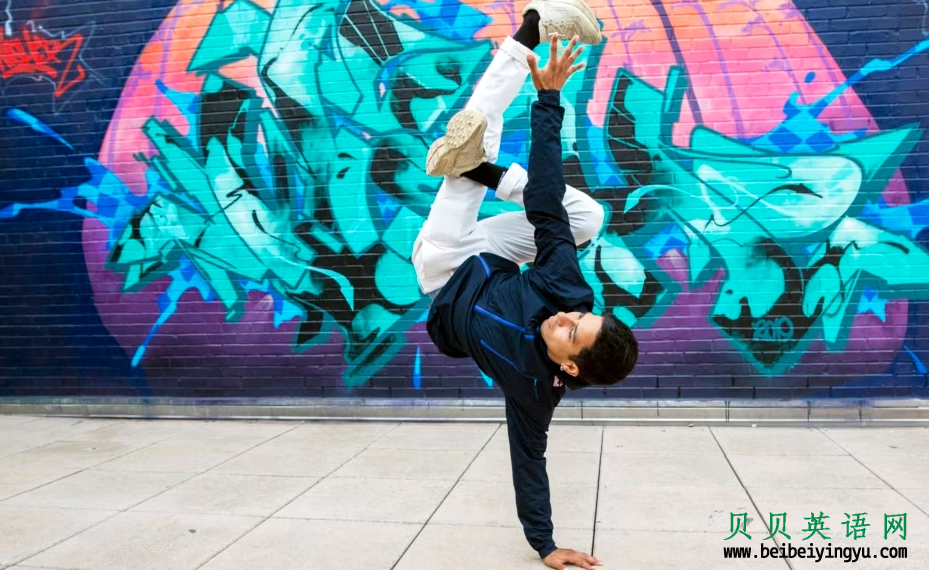欢迎访问贝贝英语网!
VOA慢速英语听力:嘻哈文化承载着抗议精神 Hip-hop Culture Carries the Spirit of Protest.
The signs of hip-hop’s influence are everywhere. American rapper and music producer Pharrell Williams recently became a creative director for the French fashion company Louis Vuitton. Other hip hop stars, including Dr. Dre, Diddy and Jay-Z, started billion-dollar fashion, lifestyle and music companies.
But it did not start out that way.
Hip-hop started 50 years ago as an escape from the poverty and violence in the Bronx area of New York City. The music and style appealed to Black and Latino teenagers. As hip-hop spread throughout New York, so did the culture.
People often mix up hip-hop with rap. Rap is a musical style that combines quick recitation of rhymes with musical beats. But hip-hop is more than just music. It is a culture, and rap music is one part of it. Hip-hop also includes other activities, like breakdancing, disc-jockeying and graffiti art.
In his 1993 song Hip Hop vs. Rap, KRS-One said: “Rap is something you do. Hip hop is something you live.”
In the early days of hip-hop, playing music on the streets or turning a basketball court into a dance floor may have seemed like a simple invitation to have fun and party. But it actually was an answer to social and economic injustice in poor neighborhoods. It was a way to show joy and imagination even without resources and wealth.
As hip-hop and rap music grew into a force in American culture, entertainers used it to speak to their personal realities. In 1982, in the song The Message, Grandmaster Flash and the Furious Five denounced poverty and a lack of investment in Black communities. Several years later, Tupac Shakur railed against police violence in the song Changes.

Today, hip-hop’s influence on music and other industries is so widespread that experts say it becomes difficult to measure. Writer Zack O’Malley Greenburg estimates that hip-hop’s five wealthiest artists were collectively worth nearly $4 billion in 2022.
There is also hip-hop’s influence on protest, resistance and political dissent around the world. From the Arab Spring and the Palestinian freedom fight to feminism and class struggles, rap music is a popular expression for calls to action. Music videos produced by artists in Africa, Europe, Asia and South America often include breakdancers, graffiti and other elements of hip-hop.
In 2016, former U.S. President Barack Obama answered questions about human rights and free expression during a visit to Vietnam. One question came from Suboi, a female rapper known as Vietnam’s “Queen of Hip-Hop.” She said she struggled against the Vietnamese stereotype that rap and hip-hop music are not a good form of expression for Asian women.
“Let’s be honest, sometimes art is dangerous and that’s why governments sometimes get nervous about art,” Obama said. “But one of the things that I truly believe is that if you try to suppress the arts, then I think you’re suppressing the deepest dreams and aspirations of a people.”
American civil rights leader Rev. Al Sharpton was 18 years old when hip-hop took off in his native New York. He said rap music fueled the movement that has shaped much of his public life. Now 68 years old, Sharpton said he believes hip-hop culture was part of what made it possible for the United States to elect its first Black president in 2008.
“Hip-hop took the chains off us and said, ‘No, we’re gonna say it our way, “ Sharpton said, “It was that freedom. It was that raw, non-watered down kind of expression.”
I'm Caty Weaver.
Words in This Story
fashion - n. the business of creating and selling new styles of clothes
teenager - n. someone between 13 and 19 years old
recitation - n. the act of describing or listing many things in a series
rhyme - n. words or phrases that end in the same sound
disc jockey - n. a person who plays recorded music on radio, at a party or a night club
graffiti - n. pictures or words drawn on a wall
chain - n. metal links or rings usually used to attach to a prisoner
参考译文:
Hip-hop的影响迹象无处不在。美国说唱歌手兼音乐制作人法瑞尔·威廉姆斯(Pharrell Williams)最近成为法国时尚公司路易威登(Louis Vuitton)的创意总监。其他嘻哈明星,包括德·德雷(Dr. Dre)、迪迪(Diddy)和杰(Jay-Z),创办了价值数十亿美元的时尚、生活方式和音乐公司。
但事情并不是从这个样子开始的。
嘻哈起源于50年前,是从纽约市布朗克斯地区的贫困和暴力中逃脱出来的。这种音乐和风格吸引了黑人和拉丁裔青少年。随着嘻哈在纽约传播,文化也随之传开。
人们经常将嘻哈和说唱混为一谈。说唱是一种将韵律快速吟唱与音乐节奏相结合的音乐风格。但嘻哈不仅仅是音乐。它是一种文化,而说唱音乐只是其中的一部分。嘻哈还包括其他活动,如霹雳舞、唱片骑师和涂鸦艺术。
在1993年的歌曲《嘻哈对决说唱》中,KRS-One说:“说唱是你所做的事情,而嘻哈是你所生活的事情。”
在嘻哈的早期,街头播放音乐或将篮球场变成舞池可能看起来像是一个简单的邀请,让人们愉快地享受派对。但实际上,这是对贫困社区中的社会和经济不公正的回应。这是一种在没有资源和财富的情况下展示快乐和想象力的方式。
随着嘻哈和说唱音乐在美国文化中的影响力增强,艺人们开始用它来反映自己的现实情况。在1982年的歌曲《信息》中,Grandmaster Flash和愤怒的五人组谴责了贫困和对黑人社区的缺乏投资。几年后,图帕克·莎库尔(Tupac Shakur)在歌曲《变革》中抨击了警察暴力。
如今,嘻哈对音乐和其他产业的影响如此广泛,以至于专家表示难以衡量。作家扎克·奥马利·格林伯格(Zack O'Malley Greenburg)估计,嘻哈音乐界五位最富有的艺人在2022年的总身价接近40亿美元。
此外,嘻哈还对全球范围内的抗议、抵抗和政治异议产生影响。从阿拉伯之春和巴勒斯坦自由斗争到女权主义和阶级斗争,说唱音乐是呼吁行动的流行表达方式。非洲、欧洲、亚洲和南美洲的艺术家制作的音乐视频经常包括霹雳舞、涂鸦和其他嘻哈元素。
2016年,美国前总统巴拉克·奥巴马(Barack Obama)在访问越南期间回答了有关人权和自由表达的问题。其中一个问题来自Suboi,她是越南的“嘻哈女王”,以她在越南的说唱和嘻哈音乐不是亚洲女性表达方式的刻板印象而闻名。
“坦率地说,有时艺术是危险的,这就是为什么政府有时会对艺术感到紧张的原因,”奥巴马说。“但我真正相信的一件事是,如果你试图压制艺术,那么我认为你在压制人民最深层次的梦想和愿望。”
美国民权领袖阿尔·夏普顿(Rev. Al Sharpton)在他的家乡纽约市嘻哈起飞时只有18岁。他说,说唱音乐助力了塑造他大部分公共生活的运动。现年68岁的夏普顿表示,他认为嘻哈文化是让美国能够在2008年选出首位黑人总统的部分原因之一。
“嘻哈解开了我们的束缚,并说,‘不,我们要用我们自己的方式来说话,’”夏普顿说,“那就是自由。那是一种原始的、未经稀释的表达方式。”
我是凯蒂·韦弗(Caty Weaver)。